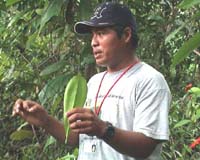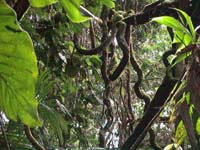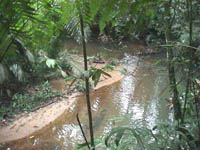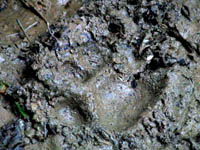 |
|||||||||||||||||||
Early this morning Nantucket Clipper anchored off the coast of Belize near the village of Dangriga. We rode boats to shore where a van was waiting for us to take us to a special place in Belize. We are going to the Cockscomb Basin Wildlife Sanctuary. This special park is the world's only jaguar sanctuary. Remember the jaguar we saw at the Belize Zoo? Well, in this huge national park the jaguars roam free. Today we will be looking for jaguars! Scientists think that there are about 35 jaguars living in the park. We probably won't see them. Jaguars usually hunt for their prey at night. Jaguars are also usually scared of people. Jaguars can smell and hear us and run away before we can get close enough to see them. After a one hour ride we arrive at Cockscomb Basin Wildlife Sanctuary. Waiting for us is our Mayan guide, Oscal Chun. Oscal will take us deep into the rainforest and tell us about the plants and animals we may find. Before we start our hike Oscal tells us to make sure we put on our insect repellant. He tells us that there is a fly here that will lay it's eggs under your skin. After a while the eggs will hatch and flies will come out of your skin! Oscal pulls a leaf off a nearby plant. A white gooey sap drips out of the end of the leaf. He says that this sap is what Mayan people use when the flies lay their eggs under their skin. They drip the sap to cover the hole in their skin and the sap seals up the hole, like super glue! Without air the eggs don't hatch and the flies die. As we walk along a muddy trail we see that the rainforest is thick with green plants and vines. Oscal points up ahead of us. It looks like a boa constrictor is hanging from a tree! Even though boa constrictors do live here this is not one; it's a twisted, snake-like vine. Oscal takes his machete and whacks off a section of the vine. He holds the end of the vine up to his mouth and drinks something coming out of it! He says this is the watervine. This vine contains cool, clean water. It is what the Mayans would drink instead of carrying water bottles. Oscal shows us another plant that was important to the Mayans. It is a palm tree, called the cohune (cah-HOON) palm. This palm had many uses. The Mayans used the fronds (leaves) for the roofs of their thatched huts. (Our hut at Ian Anderson's Jungle Lodge was made of cohune palm fronds.) Oscal shows us the nuts of this palm. They are like little coconuts about the size of a golf ball. Oscal tells us that inside is white meat like a coconut. The Mayans would squeeze the white meat to get oil that they would use for cooking oil. After they squeezed the oil out of the nut they would pound the white meat into flour. The hard shell of the nut they would use for clothing buttons and jewelry. The husk of the nut they would use for fuel for their cooking fires. We notice that a small stream runs past the cohune palm. Oscal says this is the start of the Sittee River. The Sittee River flows from the jungle to the sea. Like the Caves Branch River that we went cave tubing on this is another river that connects the rainforests to the coral reefs. Oscal calls out to us that he has found something! He is crouched down, pointing at something in the middle of the muddy trail. It is the paw print of a large jaguar! Oscar says that this is a fresh paw print. We stand quietly still, but we don't see or hear anything. Oscal tells us that this jaguar probably walked across this trail earlier this morning. Oscal leads us back to our van and says goodbye to us. We leave in our van and head further down the Sittee River. We will be taking a boat trip down the Sittee River from the jungle to sea. Join us for Part II as we travel down the Sittee River and look for crocodiles and other animals that live along the river. Best fishes, |
TODAY'S DATA Dangriga, Belize Our Mayan guide, Oscal Chun, holds the leaf with the sap that seals up fly holes in your skin.
This snake-like vine is the watervine. It has clean, cool water inside of it.
The long fronds of the cohune palm stick out over the Sittee River.
This small stream is the start of the Sittee River. The Sittee River flows into the Caribbean Sea. This river connects the rainforests to the coral reefs.
This is the large jaguar paw print we found. It is about as wide as your hand. |
||||||||||||||||||
home | basecamp | archives | library other expeditions | kids' page | contact us © 2001, The Ocean Adventure All rights reserved. |



